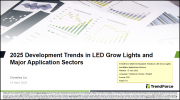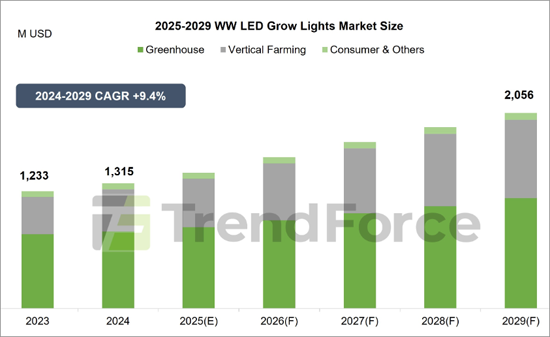
2024년의 식물 재배 LED 조명 시장은 과일 및 채소의 온실 수요의 회복과 중소규모의 수직 농원에 대한 투자 재개에 의해 회복했습니다. 고효율 제품에 의한 구기술의 대체, 조정 가능한 멀티채널 조명의 진보 등의 요인이 성장을 가속할 것으로 보여지고 있습니다.

이 보고서는 온실(비 적층형 실내 농업 포함)이 식물 재배 LED 조명의 최대 점유율을 차지하고 수직 농장과 소비자 부문이 그에 이어지는 것을 강조합니다. 온실은 시장의 60% 이상을 차지하고 수직 농장은 30% 이상을 차지합니다.
이 응용 시장 수요는 주로 LED 기술의 상당한 에너지 절약 효과로 인해 고압 나트륨(HPS) 램프에서 LED로 교체가 여전히 주류를 차지하고 있습니다. 시장의 초점은 600W 이상의 고출력 솔루션으로 옮겨가고 있으며, 600-1500W의 제품이 서서히 주류 구성이 되고 있습니다. 광합성 광자효율(PPE)의 전체적인 수준은 3.0-4.5마이크로몰/J로 상승하여 식물의 성장효율을 높일 뿐만 아니라 전체적인 생산비용도 낮추고 있습니다.
2024년 실내 대마 재배에서 식물 재배 LED 조명 수요는 감소하고 있지만, 토마토, 딸기, 포도, 꽃 등 고가치 작물에 대한 관심은 급상승하고 있습니다. 2024년 식물 재배 LED 조명 시장에서 차지하는 온실 용도의 비율은 61.5%로 2023년부터는 약간 감소하고 있지만 여전히 우세합니다. 이 부문은 2029년에 11억 5,800만 달러로 성장했으며, 2024년부터 2029년까지의 CAGR은 7.5%로 예측됩니다.
Philips, Fluence, Gavita, Agrolux, Acuity, Lumatek, Hortilux, Heliospectra, California Lightworks와 같은 주요 브랜드는 최적화된 스펙트럼 레시피와 조정 가능한 멀티채널 제어 기능을 갖춘 제품을 제공함으로써 이러한 추세에 탑승하고 있습니다. 표준 120도 빔 각도 외에도 140도 및 150도 광각 빔 각도가 인기를 끌고 있습니다.
2년간의 재조정 기간을 거쳐, 수직 농법 분야는 2024년에 회복의 조짐을 보여, 중소규모의 농장이 성장을 견인합니다. 이 농장에는 소규모 경영, 도시 커뮤니티에 서비스를 제공하는 컨테이너 농장, 슈퍼마켓 및 소매 업체가 운영하는 매장 내 농장이 포함되어 있으며, 이들 모두가 지속 가능한 수요 증가에 기여합니다.
컨테이너 농장은 도시, 섬의 리조트(스리랑카 등), 학교, 알래스카 등 자원이 부족한 지역에서 인기를 끌고 있습니다. 점포 내 농워능ㄴ 점포, 호텔, 레스토랑, 심지어 Synergy Marine Group이 관리하는 아구와 팜의 제품을 사용하는 유조선 등의 선박으로까지 확대하고 있습니다. 이 시장 부문은 2029년까지 8억 2,200만 달러에 달하고, 2024년부터 2029년까지 CAGR 13.1%가 될 것으로 예측되고 있습니다.
최신 데이터에 따르면 유럽과 아메리카의 실내 가정 채소밭과 관엽 식물에 대한 수요 증가는 소비자용 식물 재배 LED 조명의 매출 증가를 견인하고 있습니다.
이 시장은 2029년까지 7,600만 달러로 성장해, 2024년부터 2029년까지 CAGR 3.7%가 될 것으로 예측했습니다.
본 보고서에서는 세계의 식물 재배 LED 조명 시장에 대해 조사했으며, 시장 동향과 함께 부문별 동향, 지역별 동향, 주요 공급망에서경쟁 구도 등을 정리했습니다.
According to TrendForce's " 2025 Development Trends in LED Grow Lights and Major Application Sectors" report, the LED grow light market is rebounding in 2024, driven by recovering demand for greenhouse of fruits and vegetables and renewed investments in small and medium-sized vertical farms. The market size for LED grow lights in 2024 is estimated at USD 1.315 billion. Looking ahead, factors such as increasing LED adoption, replacement of older technologies with high-efficiency products boasting improved Photosynthetic Photon Efficacy (PPE) and Photosynthetic Photon Flux Density (PPFD), and advancements in adjustable multi-channel lighting are expected to fuel growth. Significant investments in emerging agricultural technologies are also encouraging growers to adopt LED solutions, pushing the market to a projected USD 2.056 billion by 2029, with a compound annual growth rate (CAGR) of 9.4% from 2024 to 2029.

The report highlights that greenhouse (including non-stacked indoor farming) account for the largest share of LED grow light applications, followed by vertical farms and the consumer segment. In 2024, greenhouses represent over 60% of the market, while vertical farms contribute more than 30%. With ongoing investments in agricultural innovation, vertical farms are expected to see a growing share of demand in the coming years.
Demand in this application market is still dominated by the replacement of High-Pressure Sodium (HPS) lamps with LEDs, primarily due to the significant energy-saving benefits of LED technology. The market focus has shifted towards high-power solutions above 600W, with products in the 600W to 1500W range gradually becoming the mainstream configuration. The overall level of Photosynthetic Photon Efficacy (PPE) has increased to 3.0-4.5 micro-mol/J, which not only boosts plant growth efficiency but also lowers overall production costs.
In 2024, demand for LED grow lights in indoor cannabis cultivation has declined, but interest in high-value crops like tomatoes, strawberries, grapes, and flowers has surged. These crops, which require strict freshness standards, are increasingly grown locally to minimize transportation costs. TrendForce estimates that greenhouse applications accounted for 61.5% of the LED grow light market in 2024, down slightly from 2023 but still dominant. This segment is projected to grow to USD 1.158 billion by 2029, with a CAGR of 7.5% from 2024 to 2029.
Leading brands such as Philips, Fluence, Gavita, Agrolux, Acuity, Lumatek, Hortilux, Heliospectra, and California Lightworks are capitalizing on this trend by offering products with optimized spectral recipes and adjustable multi-channel controls. In addition to the standard 120-degree beam angle, wider angles of 140 and 150 degrees are gaining popularity.
After a two-year period of recalibration, the vertical farming sector showed signs of recovery in 2024, with small and medium-sized farms driving growth. Factors such as rising demand for localized cultivation, a focus on fresh and healthy produce, and government subsidies are supporting profitability in this segment. These farms include smaller-scale operations, container farms serving urban communities, and in-store farms operated by supermarkets and retailers, all contributing to sustainable demand growth.
Container farms are gaining traction in urban areas, island resorts (e.g., Sri Lanka), schools, and resource-scarce regions like Alaska. In-store farms are expanding into shops, hotels, restaurants, and even maritime vessels, such as tankers using Agwa Farm products managed by Synergy Marine Group. Beyond leafy greens, high-value crops like strawberries and onions, as well as plants for breeding, are increasingly cultivated. TrendForce projects this market segment to reach USD 822 million by 2029, with a CAGR of 13.1% from 2024 to 2029.
According to TrendForce's latest data, the rising demand for indoor residential gardening and decorative plants across Europe and the Americas has driven increased sales of consumer LED grow lights., combined with accessible e-commerce platforms, has boosted sales of consumer-grade LED grow lights. In 2024, this segment accounted for 4.8% of the total market.
Looking ahead, continued passion for residential gardening in Europe and the Americas and the launch of innovative LED grow light products are set to drive further market growth. TrendForce forecasts this market to grow to USD 76 million by 2029, with a CAGR of 3.7% from 2024 to 2029.